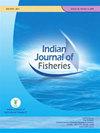不同饵料对极危半岛鲤繁殖性能的影响(Day, 1870)
IF 0.3
4区 农林科学
Q4 FISHERIES
引用次数: 0
摘要
研究了不同饵料对极危半岛鲤(Hypselobarbus pulchellus, Day, 1870)繁殖性能的影响。雄鱼和雌鱼在泥池中饲养,并饲喂以下饲料之一:(i)对照-以鱼粉为基础的饲料(粗蛋白质,CP- 35%);(ii)在对照饲料中添加2%用于家禽脂质调节的商业产品(LC饲料);(iii)在鱼粉之外添加马克和黑克的特殊配制日粮(CP 35%) (PB饲料)。2019年首次进行了育种试验。不同组间的繁殖力无显著差异。在2020年重复了该实验,将对照饲料投喂在有水草螺旋藻的池塘中饲养的鱼(C+V处理)。C+V处理的相对繁殖力和鱼苗比最高,其他养殖性能参数在不同处理间无显著差异。研究表明,在养殖环境中存在沉水植物可以提高水蛭的繁殖性能。关键词:种鱼日粮;繁殖力;诱导育种本文章由计算机程序翻译,如有差异,请以英文原文为准。
Effect of different broodstock diets on breeding performance of the critically endangered peninsular carp Hypselobarbus pulchellus (Day, 1870)
Effect of different broodstock diets on breeding performance of the critically endangered peninsular carp Hypselobarbus pulchellus (Day, 1870) was evaluated. Male and female fish were reared in earthen ponds and fed one of the following diets viz. (i) Control - Fishmeal based feed (crude protein, CP- 35%); (ii) Control feed supplemented at 2% with a commercial product used for lipid regulation in poultry (LC feed) and (iii) Specially formulated diet (CP 35%) with horse gram and black gram in addition to fishmeal (PB feed). Breeding trials were first conducted in 2019. No significant difference in fecundity was recorded among fish from different groups. The experiment was repeated in 2020, where, the Control feed was fed to fish maintained in a pond with aquatic weed Vallisneria spiralis (C+V treatment). Highest relative fecundity and spawn to fry survival was obtained with C+V treatment, there being no significant difference among other breeding performance parameters between treatments. The study indicated that the presence of submerged aquatic plants in the culture environment improves the breeding performance of H. pulchellus. Keywords: Broodstock diet, Fecundity, Induced breeding, Puntius pulchellus
求助全文
通过发布文献求助,成功后即可免费获取论文全文。
去求助
来源期刊

Indian Journal of Fisheries
FISHERIES-
CiteScore
0.90
自引率
20.00%
发文量
0
审稿时长
6-12 weeks
期刊介绍:
Indian Journal of Fisheries is published quarterly by the Indian Council of Agricultural Research (ICAR), New Delhi. Original contributions in the field of Fish and fisheries science are considered for publication in the Journal. The material submitted must be unpublished and not under consideration for publication elsewhere.
Papers based on research which kills or damages any species, regarded as thratened/ endangered by IUCN crieteria or is as such listed in the Red Data Book appropriate to the geographic area concerned, will not be accepted by the Journal, unless the work has clear conservation objectives.
 求助内容:
求助内容: 应助结果提醒方式:
应助结果提醒方式:


